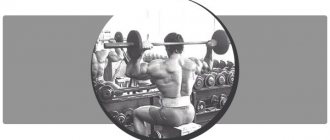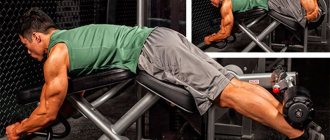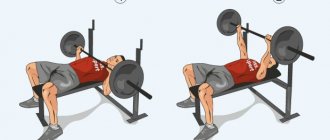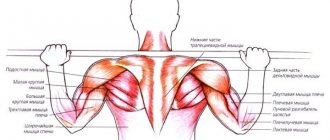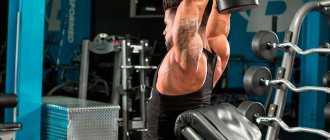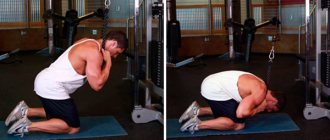What muscles does the Arnold press work?
The main task in the Arnold press is to develop the muscles of the shoulder girdle. Namely:
- Deltoid muscles. It is this press that puts a lot of stress on the front head
(initial phase).
Then it shifts to the middle head
(middle phase of execution).
And in the end, although small, the load goes to the back head
(shoulder stabilization in the upper phase). - Rotator cuff muscles. This is a group of muscles that are responsible for rotating and stabilizing the humerus. It includes: supraspinatus
,
infraspinatus
,
subscapularis
and
teres minor.
In addition to the main muscles, there are secondary ones. Who also take part in the movement. This:
- Triceps . Extends the arm at the top of the exercise.
- Coracobrachialis muscle. Responsible for flexing and adducting the shoulder to the body. That is, it actively works when returning to its original position. It also holds the humerus in the joint.
When performing the Arnold press standing, not sitting. Additionally, the muscles responsible for stabilizing the body will work.
- Press
- Back extensors
- Gluteal
- Thigh muscles (anterior and posterior groups)
- Calf muscles
This entire muscle army will serve us when performing this exercise.
What muscles work
This press allows you to work out all the bundles of deltoid muscles (there are three in total), and is involved in the formation of a powerful shoulder girdle. The main load, if the exercise is performed correctly, falls on the middle and anterior deltas. The triceps are subjected to moderate stress.
Correct technique requires the need to turn the arms, so in addition to the deltoids and triceps, the work includes:
- Trapezoid;
- Serratus anterior muscles (These are the ones above the ribs);
- Forearms;
- Infraspinatus and supraspinatus (Scapulae);
- Coracobrachialis and other rotator cuff muscles.
If in the initial phase of the exercise the main load is predominantly placed on the anterior bundles of the deltoid muscles, then at the moment of straightening the arms, the middle bundles are included in the work. The triceps are “connected” directly when you extend your arms with dumbbells.
When performing the Arnold press, you can clearly feel the tension in the latissimus dorsi and pectoralis major muscles. Since the Arnold press is a so-called formative exercise, it is recommended to perform it closer to the end of the workout. The press, which is done from a standing position, also allows you to work the oblique muscles of the back and lower back.
Advantages and disadvantages
Advantages
- In this press, the front head of the deltoid muscles is constantly under tension. This contributes to its better development.
- Helps give the shoulder muscles a more expressive shape.
- This press helps strengthen the rotator cuff muscles. Due to rotation in the shoulder joint and working with light weight.
And that, unfortunately, is all. And then the question immediately arises, how is this possible?? After all, this exercise was performed by Arnold Schwarzenegger himself, it cannot have so few benefits. In fairness, it is worth noting that his shoulders have never been his strong point. There was a particular lack of development in the middle beams. From this we can conclude that there were some flaws in the training of the eight-time Mr. Olympia. Of course I don't presume to condemn him. Because he is truly the greatest athlete. And during certain training periods, the Arnold press may even be appropriate. For example, when preparing for competitions or during drying to give them relief. But unfortunately, it is not suitable for everyday training.
Flaws
- With poor technique and incorrectly selected dumbbell weights, you can easily injure the rotator cuff muscles. They are especially vulnerable at the moment of abduction and rotation of dumbbells from the initial position to the middle one.
- A very large load falls on the front head. And since she already works in a large number of basic exercises. Starting from: DUMBELL PRESS and ending with Push-ups. There is no point in doing additional exercises for it. On the contrary, this may overwork this head. And cause injury.
- By performing the Arnold press, we will not be able to build muscle mass. Since this exercise is more aimed at giving relief.
- The exercise is not suitable for beginner athletes. Since there is a high risk of injury and very little return in muscle growth.
That is, to summarize the above. This can be concluded. That Arnold's bench press does not live up to the hopes that most athletes place on it. And most likely it is still popular, since it is named after the idol of most builders. But it is still worth considering the fact that during certain training periods this exercise can be effective. And to slightly reduce the risk of injury, you should leave room for it at the end of the workout and take light weights.
Arnold press technique
Most often, the Arnold press is performed while sitting on a bench. This gives an additional point of support. That is, we rest our feet on the floor and sit with our pelvis on the bench. Athletes who want to unload their backs can additionally rest against the back of a bench set at an angle of 80-90°. The exercise itself consists of 3 stages. Pulling the elbows to the side, turning the dumbbells and the bench press itself.
Initial position:
- Go to the bench press. If you need a backrest, then raise it to the desired height.
- Take dumbbells of the desired weight in your hands and sit down. Press your shoulder blades firmly against your back (when working without it, keep your back straight). Bend your lower back slightly.
- Spread your legs wide and place them on the floor.
- Curl your arms with the dumbbells as if you were doing a BICEPS CURL. Palms face back.
- Raise your elbows slightly upward until you feel tension in the front head of the deltoids.
Performance:
- As you exhale, we begin to move our elbows in different directions from the bottom point. And at the same time, turn the dumbbells counterclockwise. Until the palms point forward. And without pausing, press the dumbbells up in an arc. That is, at the top we bring them together a little.
- While inhaling, we return to the starting position. Doing the same thing, only in reverse order. We lower our hands down, bring our elbows together while simultaneously rotating the dumbbells clockwise.
At first, the exercise will seem difficult, and you will sometimes get confused. But after just a few approaches, your neuromuscular connection will strengthen and the movement will become familiar. The main thing is not to rush. The main goal of the exercise is to feel the work of each head of the deltas. And perform the movement by reducing them.
Types of Arnold press
The exercise can be performed standing or sitting. To perform while sitting, you will need a bench with an adjustable angle. Often people place the backrest perpendicular to the floor, but this is not entirely correct. It’s better to make the angle a little less than straight, so it will be easier for you to focus on the work of your shoulders.
Seated exercise option
The Arnold Seated Press is done as follows:
- Sit on the bench, press tightly against the back. Raise the dumbbells to shoulder level or have a partner pass them to you. Turn your hands with your knuckles facing forward. This is your starting point. By rotating the hands, the dumbbells are positioned slightly in front, this will increase the load on the front deltoid.
- Start pressing the dumbbells. When the dumbbells are approximately at forehead level, begin to unfold them. The press is done while exhaling. You need to plan your time so that you completely finish the turn by the time you squeeze them to their full amplitude.
- Without stopping at the top point, smoothly lower them down. With a turn, the principle is the same - we finish turning the dumbbells at the same time as lowering. The entire negative phase of the movement takes place while inhaling.
Step-by-step guide to the Arnold press technique on video:
Standing exercise option
The standing Arnold press is done as follows:
- The most difficult thing in this exercise is throwing the dumbbells up. If you can't do this without cheating your whole body, the weight is too heavy. Work with a weight that does not cause you discomfort when lifting the dumbbells to shoulder level.
- Straighten up, keep your back straight, move your chest slightly forward and up. Rotate the dumbbells so that your hands are knuckled forward. Start pressing them up using the same principle as the seated press. The most important thing is not to help yourself with your feet. The movement should be carried out through isolated work of the shoulders. There should be no cheating, sideways deviation or rounding of the spine.
- Inhaling, lower the dumbbells to shoulder level, while simultaneously turning them around.
Arnold Press
Performing a standing Arnold press will make the exercise more multifunctional. By engaging the muscles of the back, legs and abdomen. Which will provide stability to your body and will receive a static load. But unlike the sitting option, you will have to focus not only on the movement itself, but also on stabilizing the body. And if you take into account the fact that the Arnold press already requires good coordination. We can conclude: only professional athletes can perform this option correctly. The main thing when performing while standing is not to turn the exercise into throwing dumbbells by pushing with your legs. This will turn the exercise into a kind of shvung. And the risk of shoulder injury will increase.
Arnold One Arm Press
This is a very rare option. It is mainly used for restoration purposes. Also, working with each hand in turn, we will load the oblique abdominal muscles. Which will prevent the body from tilting towards the working arm. To be honest, I don’t see any particular advantages in this option. Since the exercise will take much longer to complete. And these costs are not so justified. But if you have a desire, you can try it in action.
Recommendations for implementation
- Movements should be under your strict control. Don't let your shoulders drop down due to inertia.
- Don't get too hung up on rotating the dumbbells. When you begin to move your elbows to the side from the starting position, your forearm will automatically begin to rotate in the desired direction.
- In the middle phase of the exercise, make sure that your elbows are in the same plane as your body (not moving forward or backward). This will allow maximum use of the middle head.
- When performing a standing press, do not help yourself press the weight by swinging. This may cause spinal injury.
- At the top point, do not straighten your arms completely. This will take the load off the deltoids and can overload the elbow joint.
Basic mistakes when performing the exercise
Too much dumbbell weight
As trivial as it may seem, it is the use of inappropriate weight that causes violation of technique and serious injuries. I don’t know why, most athletes forget about this. As for this exercise, the working weight should be much less than in classic bench presses. By about 30%. This is of course not an exact number. But it's perfect as a guide.
Strong arch in the lower back
This error stems from the first one. Athletes take large dumbbells in their hands, but they cannot squeeze them by contracting the deltoids. And in order to cope with the weight, they begin to sag in the lower back. This makes it possible to involve the pectoral muscles in the work. Which of course greatly simplifies the exercise. As a result, its effectiveness suffers and the deltoids do not receive the necessary load. But this is not the worst thing! This technique greatly overloads the spine, putting it in a very dangerous position. Consequently, over time, we can become seriously injured.
Low elbows at the starting point
When performing the Arnold press, the main task is to keep the deltoids under tension at all times. To do this, we bring our elbows forward in front of the body to load the front head. If you lower them lower, almost to the same level as the torso. The entire load will shift to the biceps. In this case, the dumbbells will have to be lifted from a dead center. And if at the beginning of the approach we will be able to do this with ease. Then towards the end, you will have to resort to cheating. And in order to squeeze the weight, we involuntarily begin to sway. In this case, the dumbbells will simply be thrown up in a big way. This technique can easily injure the muscles of the shoulder and rotator cuff.
How to perform an Arnold press?
Since research speaks volumes about the effectiveness of the Arnold press, it would be a good idea to include it in your training program.
The exercise is more difficult to perform than regular presses, so it is worth working with a lighter working weight.
You can perform the exercise standing or sitting. In a sitting position, you will most likely be able to take on more weight, since you will have a fulcrum. While standing, you will have to spend more effort maintaining your body in an upright position.
- Raise the dumbbells in front of you, bending your elbows. Hold the dumbbells suspended with your palms facing you. The triceps should not rest against the body: there should be a gap between the arms and the body.
- Take a short breath and as you exhale, begin to raise your arms up. At the same time, spread your hands to the sides, turning them away from you. At the same time, move your elbows away from you.
- Bring the dumbbells to the top point, keeping the muscles tense, but not straightening your elbows completely. Palms should face in the direction of your gaze.
- As you inhale, slowly return to the starting position in the same way you came out of it.
Tips for maximum efficiency
- Before starting your workout, be sure to do exercises to warm up your entire body. Pay special attention to the shoulder joints and neck. To warm up, you can use the usual exercises that you remember from physical education lessons.
- If you experience pain or discomfort during exercise. You should stop the exercise immediately.
- In order to increase the load on the middle head. In the middle phase (elbows moving to the sides), you need to tilt your hands slightly inward. This will shift the center of gravity slightly. This technique was used by the very first Mr. Olympia Larry Scott.
- Before performing working approaches, do 1-2 warm-up approaches with light weight.
- It is best to perform the Arnold press at the end of your workout. Using light weight and performing the exercise in an average number of repetitions. Approximately 4 sets of 12-15 reps.
- At the end of your workout, be sure to do a small set of muscle stretching exercises.
Unfortunately, the Arnold press is not effective. Yes, with its help you can slightly improve the relief of the deltoid muscles. But due to the complexity of the movement itself, it is better to choose other isolated exercises for this role. So, whether to do it or not, the decision is up to you. The main thing is not to forget about the technical points that will help you avoid injuries. If you have something to say about this bench press, I will be glad to read it in the comments.
Good luck to everyone in your training!
Execution technique
The Arnold press is usually considered a basic form of free weight exercise. Given the specificity of the movements, only dumbbells can be used. The weight chosen is relatively light; it is recommended to use dumbbells 25-35% lighter than when performing classic seated presses. This is an important point, since the shoulder joint and, in particular, the rotator cuff of the shoulder must be protected from overload at the lower point of the amplitude. Athletes who have suffered shoulder injuries should be especially careful. In addition, light weight makes it possible to increase the number of repetitions and approaches, which helps to increase blood supply to the muscles.
It is recommended to perform the Arnold press at the end of the workout, as a “finishing” exercise. The main positions are considered to be sitting and standing, although some athletes prefer to perform this bench press. Let's look at the most popular options.
Sitting
This variation was originally the main way to perform the Arnold press. The exercise requires reliable support for the spine, so you will need a chair or bench with a fairly high back. Stools or other seats with low backs under the lower back are not suitable. Lack of support can lead to injuries to the shoulder joint, so you should be careful when choosing a seat. In addition, supporting your back allows you to do more repetitions, which will make your workouts more effective. Exercise technique:
- You need to sit on a bench, straighten your back and lean against the back. The dumbbells are held with an overhand grip, with the backs of the palms facing forward. Starting position - dumbbells raised to eye level or slightly lower. The press starts from this position. The elbows should not be pressed to the body, the triceps should be at some distance from the chest.
- The athlete inhales and holds his breath. Lifting the dumbbells occurs while simultaneously turning the palms forward. Approximately half the turn occurs at the level of the top of the head, and the palms are fully turned when the full rise is achieved.
- When the dumbbells reach the top point, the position is fixed and the reverse movement begins with simultaneous exhalation. An important point is that you should not completely lower the dumbbells and relax your deltoids. This is the peculiarity of the Arnold press - the shoulders do not relax even between lifting and lowering cycles, which makes the exercise much more effective than classic presses, where the load is higher, but there are moments of almost complete relaxation of the deltoids.
There are different options for performing this exercise. Some people simplify the movement by pressing straight up, which makes it closer to the classic form. At the same time, the load on the middle part of the deltoid muscles is slightly reduced, allowing the anterior deltoids to be targeted. This method is good for those who need to draw the front sections of the shoulders, the load on which can be increased by moving the arms further forward. In addition, a full turn of the arms is also not performed by all athletes - sometimes the exercise is performed by turning the arms with the palms facing each other. These options allow you to load certain sections of the shoulders and back in more detail, ensuring the depiction of weak and little-used groups.
standing
Performing the Arnold Press from a standing position has become a more complex method that is highly effective and allows you to gain some advantages over the original version:
- The load on the middle (lateral) deltas increases.
- Tendons and ligaments are strengthened more actively.
- Allows you to increase muscle strength.
Basically, bodybuilders resort to standing presses to work their side delts. The effectiveness of this version of the exercise has been tested and confirmed in practice, but some difficulties with the spine have also been identified - if you have a disease or previous injuries, you should avoid doing the standing press.
Technique for performing a standing Arnold press:
- Take dumbbells in your hands, stand straight, bend your back slightly, slightly sticking your chest forward. The position should be natural, without excessive bending of the spine. Feet are shoulder-width apart, gaze directed straight ahead.
- The dumbbells must be raised in front of you to face height. Palms are turned towards you. Forearms are parallel to each other. This is the starting position. Movement begins from there.
- Lifting the dumbbells begins with simultaneous spreading of the elbows to the sides and turning the hands with the palms facing away from you. The movement is performed while exhaling. The rotation of the elbows and hands is evenly distributed along the entire trajectory of movement; you should not turn them sharply at one point.
- Returning to the starting position is performed in the reverse order.
There are different options for performing this exercise. So, some people work with one dumbbell. This allows you to even out the condition of individual muscle groups, but requires the use of much less weight.
The Arnold press is equally useful for both beginners and experienced, trained athletes. It is recommended to use several sets (approaches) with a certain number of repetitions. Typically, trainers recommend a training regimen of 4-5 sets of 10-15 repetitions. In general, the question is not so much the number of movements, but the selected dumbbell weight. On this issue, all mentors are unanimous - you need to choose a load that is approximately 65-70% of the usual weight for classic types of bench press.
It is recommended to perform these exercises at the end of your workout, after heavy exercise.
